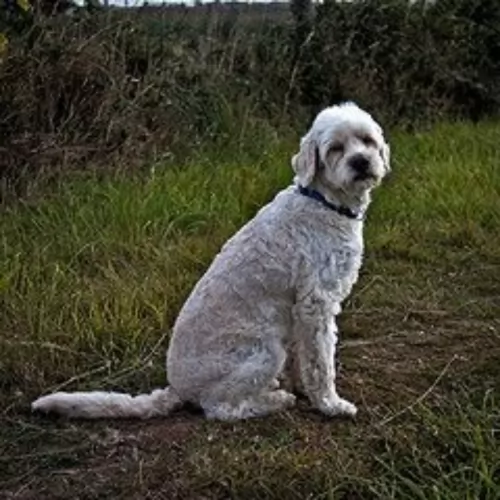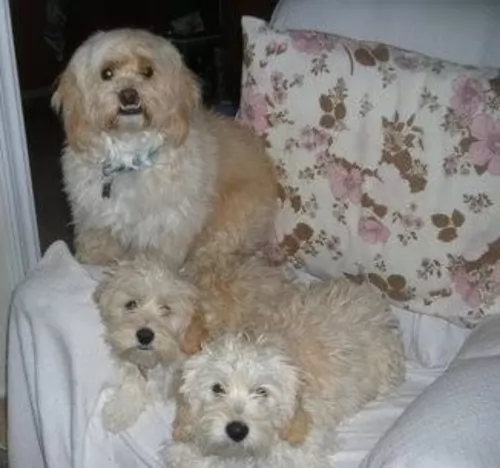 Petzlover
Petzlover Braque Saint-Germain is originated from France but Cyprus Poodle is originated from Cyprus. Braque Saint-Germain may grow 32 cm / 13 inches higher than Cyprus Poodle. Braque Saint-Germain may weigh 29 kg / 64 pounds more than Cyprus Poodle. Both Braque Saint-Germain and Cyprus Poodle has same life span. Both Braque Saint-Germain and Cyprus Poodle has almost same litter size. Braque Saint-Germain requires Low Maintenance. But Cyprus Poodle requires Moderate Maintenance
Braque Saint-Germain is originated from France but Cyprus Poodle is originated from Cyprus. Braque Saint-Germain may grow 32 cm / 13 inches higher than Cyprus Poodle. Braque Saint-Germain may weigh 29 kg / 64 pounds more than Cyprus Poodle. Both Braque Saint-Germain and Cyprus Poodle has same life span. Both Braque Saint-Germain and Cyprus Poodle has almost same litter size. Braque Saint-Germain requires Low Maintenance. But Cyprus Poodle requires Moderate Maintenance
 The Braque Saint-Germain, also known as the St. Germain Pointing Dog, is a French creation. The French pointing dogs and the English pointing dogs were mixed to develop the Braque Saint-Germain. He is a versatile hunting dog that was both a pointer and a gun dog. They are medium to large in size and went from being bred by royalty in the 1830’s to a popular everyday hunting dog. The ancestry of the breed can be traced back many additional centuries.
The Braque Saint-Germain, also known as the St. Germain Pointing Dog, is a French creation. The French pointing dogs and the English pointing dogs were mixed to develop the Braque Saint-Germain. He is a versatile hunting dog that was both a pointer and a gun dog. They are medium to large in size and went from being bred by royalty in the 1830’s to a popular everyday hunting dog. The ancestry of the breed can be traced back many additional centuries.
As popular as the Braque Saint-Germain was as a hunter, he gained his notoriety in the show ring. The first time a Braque Saint-Germain entered the ring in 1863 it was an acclaimed breed and upstaged all other pointing breeds. The French Braque Saint-Germain club was opened in 1913 and recognized by the Federation Cynoloqique International (FCI) and in 2006 was recognized by the North American United Kennel Club. Their popularity has risen and fallen since World War II. It has flirted with extinction more than once. Today’s Braque Saint-Germain is a highly talented hunting dog with a standard appearance that still does well in the ring.
The English Pointer was a cross between the hound dogs, British gundog, Spanish Pointer and herding breeds. This made the English Pointer a very versatile breed before it was crossed with the Braque Francais Gascogne. The Braque Francais Gascogne itself is believed to have developed from the Chien d-Oysel and Italian and Spanish pointing dogs. The English Pointer was specialized in pointing and the French Braque Francais Gascogne was a very versatile dog. In the Braque Saint-Germain the dog world has a versatile, excellent pointing dog.
In the 1800’s the French Crown was gifted with two English Pointers that were great at hunting. Some considered the English Pointers to be better than any of their Braque Francais. The female of these two pointers was bred many times but the male died without breeding. The female’s first litter was with a brown German Spaniel and were of low quality. Her second litter however was with an outstanding bird dog and produced 7 excellent puppies. Because of this these two dogs were bred several more times. The owner of the adult dogs moved to Saint-Germain, where their appearance attracted many hunters. The breed flourished here and was named the Braque Saint-Germain.
Soon corrupt individuals sold non-purebreds as Braque Saint-Germains and handlers showed these dogs under the Saint-Germain name. There are always dangers when a popular breed’s beginnings comes from only two dogs. In 1913 the new breed club fought over the standard and ended up producing two types. The first type was a sturdy dog with long ears and a round chest. He was larger and slower than his cousin. The second type was a smaller dog with a finer skeleton and short, high set ears. He was a galloper to his cousin’s trot.
The breed found itself facing near extinction in 1914 and during all of World War I. Dogs were not bred and many were not properly cared for. The breed became quite rare. Then as it began to recover, the Second World War intervened and devasted the breed again. By the end of the war, they were once again very rare and on the edge of extinction. It took a dedicated effort from local breeders to bring the breed back. By the 1950’s the two types of Braque Saint-Germain dogs were molded into only one breed. There remained a conflict between those that bred show dogs and those that bred hunting dogs.
Slowly the breed grew in number and in the late 1990’s there were over 100 puppies registered into the club every year. More than 100 were entered into the clubs in 2009. There have also been a few English Pointer crosses allowed to breed with the Braque Saint-Germains in order to grow and improve the gene pool. Still the breed is exceedingly rare outside of France. Through it all the breed has been able to maintain its place in confirmation and still be a versatile hunting dog.
 Unfortunately the Island of Cyprus may well be beautiful and have a wonderful climate, but when you take a deeper look, the island has a serious problem with feral cats and stray dogs.
Unfortunately the Island of Cyprus may well be beautiful and have a wonderful climate, but when you take a deeper look, the island has a serious problem with feral cats and stray dogs.
The many sanctuaries battle to keep up with the volume of neglected and abandoned animals on the island. One of the dogs found on the Island of Cyprus is the Cyprus Poodle. Some people say that the Cyprus Poodle is a cross between a poodle and a terrier.
Today this small dog is sought after in other countries for his loving personality and attractive looks.
 The Braque Saint-Germain is very much a pointer and yet is a very attractive dog. They have a medium build, drop ears and a long, level tail tapered at the end. They are really distinctive looking with an athletic, lean, muscled look. The skull is round and the muzzle is the same length as the skull. Their nose is pink , their lips cover their lower jaw and their eyes are golden, round and large. The ears are set high on the head and look like they are slightly detached. The neck is long, muscular and arched, while they have deep chest. They are well proportioned, good looking dogs with a friendly facial expression. Their coat is true to the pointing dog group as it is short, smooth and white with orange markings. Dogs of any other color might be great hunting dogs but are not show dogs and should not be bred
The Braque Saint-Germain is very much a pointer and yet is a very attractive dog. They have a medium build, drop ears and a long, level tail tapered at the end. They are really distinctive looking with an athletic, lean, muscled look. The skull is round and the muzzle is the same length as the skull. Their nose is pink , their lips cover their lower jaw and their eyes are golden, round and large. The ears are set high on the head and look like they are slightly detached. The neck is long, muscular and arched, while they have deep chest. They are well proportioned, good looking dogs with a friendly facial expression. Their coat is true to the pointing dog group as it is short, smooth and white with orange markings. Dogs of any other color might be great hunting dogs but are not show dogs and should not be bred
 The Cyprus Poodle is such an attractive little dog with his jaunty personality and his dense, curly hair.
The Cyprus Poodle is such an attractive little dog with his jaunty personality and his dense, curly hair.
He stands in the region of 20 to 30cm and can weigh roughly 3 to 6kg. His hair is essentially cream or white with orangey tips and some people claim he is a cross between a poodle and a terrier.
He is a small dog. His curly coat is woolly and can be in a number of different colors such as white, ivory or apricot or even other colors.
The curly haired Cyprus Poodle isn’t a huge shedder but regular clipping keeps him looking nice and makes sure the coat doesn’t matt.
He has floppy ears, a long tail and brown eyes. He loves to go for a swim and then to dart around the place so he may require a bath every now and again to keep his beautiful coat clean and free of matting.
The Cyprus Poodle is an even tempered dog and he makes the perfect family pet, forming close bonds with his human family members.
He is playful, social and friendly and gets on well with children in the home as well as any other pets. He may be a small, friendly dog, but he will need training and socialization if you want him to be obedient and relaxed around other people.
 The Braque Saint-Germain is a working dog and a show dog. They are energetic, competitive and driven. They are generally affectionate, loyal and love to cuddle with their people. They need human companionship companionship and can have severe separation anxiety when left by themselves. They love being a member of the family with children, but they are likely to knock very young children down unintentionally.
The Braque Saint-Germain is a working dog and a show dog. They are energetic, competitive and driven. They are generally affectionate, loyal and love to cuddle with their people. They need human companionship companionship and can have severe separation anxiety when left by themselves. They love being a member of the family with children, but they are likely to knock very young children down unintentionally.
The Braque Saint-Germain is a loyal, gentle breed and some might even be shy. They are not guard dogs. They are much too friendly toward strangers. Even though they were bred to point and track small game, they can be socialized to be safe living with smaller pets such as cats. They are intelligent, fast learners who love to learn. They also love to work and work long hours without fatigue. They will love to be a jogging or cycling partner.
They do best with large yards, rural areas or in hunting packs. They are not small apartment, city dwellers. They do get along with strangers and other animals. They will warn of strangers, but they are not aggressive.
 Your Cyprus Poodle is just dying to be a member of a human family because he has a lot of love and friendliness to give.
Your Cyprus Poodle is just dying to be a member of a human family because he has a lot of love and friendliness to give.
He wants lots of love and attention in return though. He doesn’t like to be put out in the garden and forgotten about. Make sure that he is a fully involved family member.
He is such a friendly, loving, social little dog and in exchange for your love and care, he is guaranteed to make you a most wonderful and loyal friend.
 The breed has very few health issues even with all the cross breeding followed by inbreeding. Due to the small gene pool there might be some genetically inherited problems. Due to the size of the gene pool, they might suffer from “founder’s effect” where if one dog has a certain condition, their descendants could also. Not enough research has been done to know if this is the case with the Braque Saint-Germain of not.
The breed has very few health issues even with all the cross breeding followed by inbreeding. Due to the small gene pool there might be some genetically inherited problems. Due to the size of the gene pool, they might suffer from “founder’s effect” where if one dog has a certain condition, their descendants could also. Not enough research has been done to know if this is the case with the Braque Saint-Germain of not.
Some of the potential health issues that the3 Braque Saint-Germain might face include:
 Because the Cyprus Poodle is a cross-breed, he is a robust, long-life dog and not likely to get ill very easily.
Because the Cyprus Poodle is a cross-breed, he is a robust, long-life dog and not likely to get ill very easily.
Your Cyprus Poodle can have between 1 to 6 puppies but there are tremendous health benefits waiting for your pet when you ensure that he is rather neutered or spayed in the case of a female. Make sure too that he has all his vaccinations up to date. Make sure he has an excellent diet, a warm, dry place to sleep, he is exercised and that he gets regular check-ups from the vet.
There are some common dog illnesses that you want to look out for. When he is a puppy make sure that he gets the necessary vaccination against life threatening illnesses such as parvovirus, distemper and rabies.
There are some diseases that do affect poodles a little more than with other breeds, and one of these is Cushing’s Disease.
This is an illness that comes about when the body of your dogs makes too much cortisol. It is difficult for you to see symptoms of this disease in your pet, but if he is displaying unusual behavior, then you want to get him to the vet who can decide on treatment for him.
 This is a working dog that can run and track for miles. She needs good nutrition. Feed about 3 cups per day in one or two meals. Two meals are preferred.
This is a working dog that can run and track for miles. She needs good nutrition. Feed about 3 cups per day in one or two meals. Two meals are preferred.
As previously mentioned this breed might be susceptible to many genetic diseases or disorders but there have not been any studies to show this.
The Braque Saint Germain does not need a high amount of exercise as their energy level is medium. They still need daily exercise. They do best with a fenced off leash area to run. They love frisbee and chasing balls.
 A cyprus poodle makes such a good pet and you will want to ensure that you feed your one an excellent diet so that he remains healthy and content.
A cyprus poodle makes such a good pet and you will want to ensure that you feed your one an excellent diet so that he remains healthy and content.
Some people are overwhelmed at the sheer variety of commercially manufactured dog foods today, but the choice can be made a lot simpler by sticking to the better quality ones where protein is at the top of the ingredients list.
Home made food such as cooked brown rice, vegetables and cooked chicken will be excellent for your Cyprus Poodle as well as including some raw meat in the diet. Make sure he always has access to cool, clean water as this water is essential to his health, making it possible for all his bodily functions.
Brush his hair regularly and brush his teeth 2 or 3 times a week. Make sure to use toothpaste and toothbrush specially designed for dogs.
Your poodle will happily slot into life with you in the city or the country, but even if you have a garden, you can’t expect your dog to always find his own entertainment. Take your poodle for walks and play games with him so that he remains healthy and content.